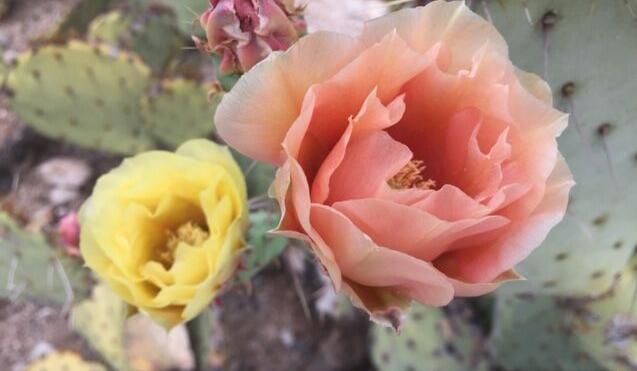The prickly pear cactus is probably the most identifiable plant (besides the saguaro) in the Sonoran Desert. The species most often seen in the wild here is Engelmann prickly pear, or Opuntia engelmannii, but other species, such as the Opuntia humifusa, or Eastern prickly pear, can be found in all of the lower 48 states.
Engelmann’s prickly pear, along with 17 other prickly pear species, is found in all of our southwest deserts — Mojave, Great Basin, Sonoran and Chihuahuan. It’s the state cactus of Texas and is on the coat of arms of Mexico. Prickly pears hybridize easily between the various species, so classifying ones in the wild can be tricky. They have beautiful, fragrant (and edible) flowers, which can be pinkish, yellow, reddish, or even a combination of these on the same plant. On yellow-flowering plants, the blooms slowly change color t a pinkish yellow. This attracts different pollinators, which increase the chances of pollination. They flower in the spring, usually by May, and the fruits can be found after July. In our desert, they make great habitat for pack rats, as their spines provide lots of protection.
The plant has been an important food source for native inhabitants for many hundreds of years. The young pads, or nopales, can be cooked and eaten like a vegetable, while the fruits, which ripen in the summer, can be eaten raw or turned into juices and jellies. If you want to try these out, make sure you know how to remove the glochids, or tiny spines, which are present on all parts of the plant and can’t be washed or rinsed away. Usually the glochids are burned away, and then the fruit or pad is peeled and rinsed as an extra precaution. The pads have lots of vitamin C and some antioxidants are present in both pads and fruit.
The plant also has medicinal uses. It’s been used by native tribes topically as and anti-infective and anti-inflammatory agent. Recent studies have suggested that the pectin in the pads and fruit may reduce cholesterol and help treat high blood sugar.
Opuntia species are also hosts for the cochineal insect, Dactylopius coccus, which was used to make red dye throughout the Aztec, Maya and Inca empires, and is still used today in food and cosmetics.
Horticulturally, a number of species and varieties are available in our area. One of the better known is the Santa Rita prickly pear (O. santa-rita), which is a beautiful purple color. There are varieties with short or long thorns, different colored pads and thorns, and different sizes of pads. As noted above, these can hybridize with each other in the landscape, creating new and interesting combinations. Prickly pears are great for areas where you want a natural look, or to create habitat for smaller creatures. It’s also a great plant for security — when planted around a wall or fence, it will deter even the most determined intruders.
Prickly pears thrive in poor soil, full sun and drought environments, but can also tolerate less hostile places. Sizes vary depending on species and variety; Engelmann’s prickly pear can grow 5 feet tall and 10-15 feet wide. They are easily trimmed back, and the pruned pads can be replanted for easy propagation.
When handling prickly pears, either for harvesting or for planting, use cooking tongs. All species have tiny, hard to see glochids which are painful and difficult to remove from your skin. Don’t ever touch the cactus or any of its parts, not even with gloves. For more information on preparing prickly pear and some recipes, take a look at Prickly Pear Cactus: Food of the Desert from the University of Arizona Cooperative Extension.





